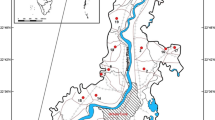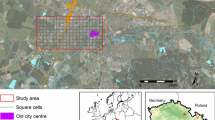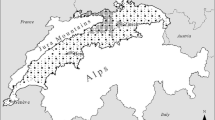Abstract
Urban areas are strongly transformed by the human population and these environmental changes can affect the richness and composition of invasive alien trees (IAT) across cities. In this study, we investigate the role of urbanization and climate variables on richness and species composition of IAT in cities from Brazil. We investigated (i) the relative contribution and how variables related to urbanization affects the patterns of richness and composition; and (ii) the relative contribution and how variables related to climate affects richness and composition of IAT. Thus, we used occurrences of IAT in 93 urban areas in Brazil gathered from 130 references. We tested the variation partitioning using three models with variables related to urbanization, climate, and spatial correlation for richness and species composition of IAT. Next, we tested the significance of each set of variables on the richness and species composition of IAT. Urbanization variables explained 18% of the variation in species richness of IAT, whereas climate explained 18% of the variation in species composition of IAT. Demographic density (habitants per km2) positively affected the richness of IAT, whereas the percentage of urban forest influenced species composition. Köppen climate zones affected richness while the covariate temperature annual range had a negative effect on richness. Temperature annual range, annual precipitation, precipitation of driest quarter, and precipitation of warmest quarter affected the species composition of IAT. We confirmed urban variables have a relevant influence on species richness, but climate variables are still important to understand the composition of IAT across cities. Thus, species richness is affected at a local scale by urbanization, and species composition by climate at broader scales.




Similar content being viewed by others
References
Adelino JRP, Heringer G, Diagne C et al (2021) The economic costs of biological invasions in Brazil: a first assessment. NeoBiota 67:349–374. https://doi.org/10.3897/neobiota.67.59185
Alvares CA, Stape JL, Sentelhas PC et al (2014) Köppen’s climate classification map for Brazil. Meteorol Zeitschrift 22:711–728. https://doi.org/10.1127/0941-2948/2013/0507
Aronson MFJ, Nilon CH, Lepczyk CA et al (2016) Hierarchical filters determine community assembly of urban species pools. Ecology 97:2952–2963. https://doi.org/10.1002/ecy.1535
Aronson MFJ, Patel MV, O’Neill KM, Ehrenfeld JG (2017) Urban riparian systems function as corridors for both native and invasive plant species. Biol Invasions 19:3645–3657. https://doi.org/10.1007/s10530-017-1583-1
Arruda DM, Fernandes-Filho EI, Solar RRC, Schaefer CEGR (2017) Combining climatic and soil properties better predicts covers of Brazilian biomes. Sci Nat 104(3):1–10. https://doi.org/10.1007/s00114-017-1456-6
Barbosa LA, Lopes CGR, Lopes WGR (2015) Levantamento das espécies vegetais das praças de São João dos Patos – MA. Rev Da Soc Bras Arborização Urbana 10:19. https://doi.org/10.5380/revsbau.v10i1.63372
Base de Dados Nacional de Espécies Exóticas Invasoras (2020) Instituto Hórus de Desenvolvimento e Conservacação Ambiental, Florianópolis, Brazil. https://i3n.institutohorus.org.br/www. Accessed 19 May 2020
Blackburn TM, Pyšek P, Bacher S et al (2011) A proposed unified framework for biological invasions. Trends Ecol Evol 26:333–339. https://doi.org/10.1016/j.tree.2011.03.023
Borcard D, Gillet F, Legendre P (2011) Numerical Ecology with R. Springer, New York
Borges ER, Dexter KG, Bueno ML et al (2020) The evolutionary diversity of urban forests depends on their land-use history. Urban Ecosyst 23:631–643. https://doi.org/10.1007/s11252-020-00938-y
Boyle B, Hopkins N, Lu Z et al (2013) The taxonomic name resolution service: an online tool for automated standardization of plant names. BMC Bioinformatics 14(1):16. https://doi.org/10.1186/1471-2105-14-16
Brooks TM, Mittermeier RA, Da Fonseca GAB et al (2006) Global biodiversity conservation priorities. Science 313:58–61. https://doi.org/10.1126/science.1127609
Carlos-Júnior LA, Spencer M, Neves DM et al (2019) Rarity and beta diversity assessment as tools for guiding conservation strategies in marine tropical subtidal communities. Divers Distrib 25:743–757. https://doi.org/10.1111/ddi.12896
Castro-Díez P, Vaz AS, Silva JS et al (2019) Global effects of non-native tree species on multiple ecosystem services. Biol Rev 94:1477–1501. https://doi.org/10.1111/brv.12511
Cazetta AL, Zenni RD (2019) Pine invasion decreases density and changes native tree communities in woodland Cerrado. Plant Ecol Divers 13:85–91. https://doi.org/10.1080/17550874.2019.1675097
dos Santos AR, da Rocha CFD, Bergallo HG (2010) Native and exotic species in the urban landscape of the city of Rio de Janeiro, Brazil: Density, richness, and arboreal deficit. Urban Ecosyst 13:209–222. https://doi.org/10.1007/s11252-009-0113-z
Dray S, Legendre P, Peres-Neto PR (2006) Spatial modelling: a comprehensive framework for principal coordinate analysis of neighbour matrices (PCNM). Ecol Modell 196:483–493. https://doi.org/10.1016/j.ecolmodel.2006.02.015
Dufrêne M, Legendre P (1997) Species assemblages and indicator species: the need for flexible asymmetrical approach. Ecol Monogr 67:345–366
Farias AR, Mingoti R, do Valle LB et al (2017) Identificação, mapeamento e quantificação das áreas urbanas do Brasil. Comunicado técnico, Empresa Brasileira de Pesquisa Agropecuária - EMBRAPA. https://geoinfo.cnpm.embrapa.br/layers/geonode%3Aareas_urbanas_br_15. Accessed 19 Jul 2021
Field R, Hawkins BA, Cornell HV et al (2009) Spatial species-richness gradients across scales: A meta-analysis. J Biogeogr 36:132–147. https://doi.org/10.1111/j.1365-2699.2008.01963.x
Fox J, Weisberg S (2019) An {R} Companion to Applied Regression, Third Edition. Thousand Oaks CA: Sage. https://socialsciences.mcmaster.ca/jfox/Books/Companion/. Accessed 19 May 2020
Franzese J, Raffaele E (2017) Fire as a driver of pine invasions in the Southern Hemisphere: a review. Biol Invasions 19:2237–2246. https://doi.org/10.1007/s10530-017-1435-z
Gaertner M, Wilson JRU, Cadotte MW et al (2017) Non-native species in urban environments: patterns, processes, impacts and challenges. Biol Invasions 19:3461–3469. https://doi.org/10.1007/s10530-017-1598-7
Gastauer M, Saporetti-Junior AW, Valladares F, Meira-Neto JAA (2017) Phylogenetic community structure reveals differences in plant community assembly of an oligotrophic white-sand ecosystem from the Brazilian Atlantic Forest. Acta Bot Brasilica 31:531–538. https://doi.org/10.1590/0102-33062016abb0442
Heringer G, Angulo E, Ballesteros-Mejia L et al (2021) The economic costs of biological invasions in Central and South America: a first regional assessment. NeoBiota 67:401–426. https://doi.org/10.3897/neobiota.67.59193
Heringer G, Bueno ML, Meira-Neto JAA et al (2019a) Can Acacia mangium and Acacia auriculiformis hinder restoration efforts in the Brazilian Atlantic Forest under current and future climate conditions? Biol Invasions 21:2949–2962. https://doi.org/10.1007/s10530-019-02024-7
Heringer G, Thiele J, do Amaral CH et al (2020) Acacia invasion is facilitated by landscape permeability: The role of habitat degradation and road networks. Appl Veg Sci 23:598–609. https://doi.org/10.1111/avsc.12520
Heringer G, Thiele J, Meira-Neto JAA, Neri AV (2019b) Biological invasion threatens the sandy-savanna Mussununga ecosystem in the Brazilian Atlantic Forest. Biol Invasions 21:2045–2057. https://doi.org/10.1007/s10530-019-01955-5
IBGE – Instituto Brasileiro de Geografia e Estatística (2012) Censo Demográfco 2010: Características urbanísticas do entorno dos domicílios. Rio de Janeiro
IBGE – Instituto Brasileiro de Geografia e Estatística (2019) Biomas e sistema costeiro-marinho do Brasil. IBGE, Rio de Janeiro
Kennedy TA, Naeem S, Howe KM et al (2002) Biodiversity as a barrier to ecological invasion. Nature 417:636–638. https://doi.org/10.1038/nature00776
Kowarik I (2011) Novel urban ecosystems, biodiversity, and conservation. Environ Pollut 159:1974–1983. https://doi.org/10.1016/j.envpol.2011.02.022
Kühn I, Wolf J, Schneider A (2017) Is there an urban effect in alien plant invasions? Biol Invasions 19:3505–3513. https://doi.org/10.1007/s10530-017-1591-1
Legendre P, Borcard D, Peres-Neto PR (2005) Analyzing beta diversity: partitioning the spatial variation of community composition data. Ecol Monogr 75:435–450. https://doi.org/10.1890/04-0988
Legendre P, Gallagher ED (2001) Ecologically meaningful transformations for ordination of species data. Oecologia 129:271–280. https://doi.org/10.1007/s004420100716
Legendre P, Legendre L (2000) Numerical Ecology, 2nd edn. Elsevier, Amsterdam
Lehmann JR, Prinz T, Ziller SR et al (2017) Open-Source processing and analysis of aerial imagery acquired with a low-cost Unmanned Aerial System to support invasive plant management. Front Environ Sci 5. https://doi.org/10.3389/fenvs.2017.00044
Lockwood JL, Cassey P, Blackburn T (2005) The role of propagule pressure in explaining species invasions. Trends Ecol Evol 20:223–228. https://doi.org/10.1016/j.tree.2005.02.004
MapBiomas Project – Coleção 5.0 (2020) da série anual de mapas de cobertura e uso de solo do Brasil. https://mapbiomas.org/download. Accessed 20 Jul 2021
Mayer K, Haeuser E, Dawson W et al (2017) Naturalization of ornamental plant species in public green spaces and private gardens. Biol Invasions 19:3613–3627. https://doi.org/10.1007/s10530-017-1594-y
McLean P, Gallien L, Wilson JRU et al (2017) Small urban centres as launching sites for plant invasions in natural areas: insights from South Africa. Biol Invasions 19:3541–3555. https://doi.org/10.1007/s10530-017-1600-4
Meira-Neto JAA, da Silva MCNA, Tolentino GS et al (2017) Early Acacia invasion in a sandy ecosystem enables shading mediated by soil, leaf nitrogen and facilitation. Biol Invasions 20:1567–1575. https://doi.org/10.1007/s10530-017-1647-2
Moro MF, Westerkamp C, De Araújo FS (2014) How much importance is given to native plants in cities’ treescape? A case study in Fortaleza, Brazil. Urban for Urban Green 13:365–374. https://doi.org/10.1016/j.ufug.2014.01.005
Myers N, Mittermeier RA, Mittermeier CG et al (2000) Biodiversity hotspots for conservation priorities. Nature 403:853–858. https://doi.org/10.1038/35002501
Nentwig W, Mebs D, Vilà M (2017) Impact of non-native animals and plants on human health. In: Vilà M, Hulme PE (eds) Impact of biological invasions on ecosystem services. Springer, Cham, pp 277–294
Neves DM, Dexter KG, Pennington RT et al (2015) Environmental and historical controls of floristic composition across the South American Dry Diagonal. J Biogeogr 42:1566–1576. https://doi.org/10.1111/jbi.12529
Nychka D, Furrer R, Paige J, Sain S (2017) “fields: Tools for spatial data.”, R package version 10.3. https://github.com/NCAR/Fields. https://doi.org/10.5065/D6W957CT. Accessed 19 May 2020
Oksanen J, Blanchet FG, Friendly M et al (2019) Vegan: community ecology package. R package version 2.5–6. https://CRAN.R-project.org/package=vegan. Accessed 19 May 2020
Padayachee AL, Irlich UM, Faulkner KT et al (2017) How do invasive species travel to and through urban environments? Biol Invasions 19:3557–3570. https://doi.org/10.1007/s10530-017-1596-9
Peres-Neto PR, Legendre P, Dray S, Borcard D (2006) Variation partitioning of species data matrices: Estimation and comparisons of fractions. Ecology 87:2614–2625. https://doi.org/10.1890/0012-9658(2006)87[2614:VPOSDM]2.0.CO;2
Potgieter LJ, Cadotte MW (2020) The application of selected invasion frameworks to urban ecosystems. NeoBiota 386:365–386. https://doi.org/10.3897/neobiota.62.50661
Potgieter LJ, Gaertner M, Kueffer C et al (2017) Alien plants as mediators of ecosystem services and disservices in urban systems: a global review. Biol Invasions 19:3571–3588. https://doi.org/10.1007/s10530-017-1589-8
Pyles MV, Magnago LFS, Borges ER et al (2020) Land use history drives differences in functional composition and losses in functional diversity and stability of Neotropical urban forests. Urban for Urban Green 49:e126608. https://doi.org/10.1016/j.ufug.2020.126608
Pyšek P, Hulme PE, Simberloff D et al (2020) Scientists’ warning on invasive alien species. Biol Rev. https://doi.org/10.1111/brv.12627
R Core Team (2020) R: A language and environment for statistical computing. R Foundation for Statistical Computing, Vienna. https://www.R-project.org/. Accepted 19 May 2020
Rezende VL, Bueno ML, Eisenlohr PV, Oliveira-Filho AT (2018) Patterns of tree species variation across southern South America are shaped by environmental factors and historical processes. Perspect Plant Ecol Evol Syst 34:10–16. https://doi.org/10.1016/j.ppees.2018.07.002
Rezende VL, Pontara V, Bueno ML et al (2020) Climate and evolutionary history define the phylogenetic diversity of vegetation types in the central region of South America. Oecologia 192:191–200. https://doi.org/10.1007/s00442-019-04561-3
Ricotta C, Rapson GL, Asmus U et al (2017) British plants as aliens in New Zealand cities: residence time moderates their impact on the beta diversity of urban floras. Biol Invasions 19:3589–3599. https://doi.org/10.1007/s10530-017-1590-2
Roberts DW (2019) Labdsv: ordination and multivariate analysis for ecology. R package version 2.0–1. https://CRAN.R-project.org/package=labdsv. Accessed 19 May 2021
Scarano FR, Ceotto P (2015) Brazilian Atlantic forest: impact, vulnerability, and adaptation to climate change. Biodivers Conserv 24:2319–2331. https://doi.org/10.1007/s10531-015-0972-y
Simberloff D (2009) The role of propagule pressure in biological invasions. Annu Rev Ecol Evol Syst 40:81–102. https://doi.org/10.1146/annurev.ecolsys.110308.120304
Siviero A, Delunardo TA, Haverroth M et al (2012) Plantas medicinais em quintais urbanos de Rio Branco, Acre. Rev Bras Plantas Med 14:598–610. https://doi.org/10.1590/S1516-05722012000400005
Souza CM, Shimbo JZ, Rosa MR et al (2020) Reconstructing three decades of land use and land cover changes in brazilian biomes with landsat archive and earth engine. Remote Sens 12(17):2735. https://doi.org/10.3390/RS12172735
Uchida K, Blakey RV, Burger JR et al (2020) Urban biodiversity and the importance of scale. Trends Ecol Evol 36:123–131. https://doi.org/10.1016/j.tree.2020.10.011
van Kleunen M, Xu X, Yang Q et al (2020) Economic use of plants is key to their naturalization success. Nat Commun 11:e3201. https://doi.org/10.1038/s41467-020-16982-3
Walker GA, Robertson MP, Gaertner M et al (2017) The potential range of Ailanthus altissima (tree of heaven) in South Africa: the roles of climate, land use and disturbance. Biol Invasions 19:3675–3690. https://doi.org/10.1007/s10530-017-1597-8
Williams NSG, Schwartz MW, Vesk PA et al (2009) A conceptual framework for predicting the effects of urban environments on floras. J Ecol 97:4–9. https://doi.org/10.1111/j.1365-2745.2008.01460.x
Zenni RD (2015) The naturalized flora of Brazil: A step towards identifying future invasive non-native species. Rodriguesia 66:1137–1144. https://doi.org/10.1590/2175-7860201566413
Zenni RD, Simberloff D (2013) Number of source populations as a potential driver of pine invasions in Brazil. Biol Invasions 15:1623–1639. https://doi.org/10.1007/s10530-012-0397-4
Acknowledgements
We acknowledge Anne-Sophie de Almeida, Bráulio Santos, Bruno de Macêdo, Carla dos Santos, Deivid Kern, Frederico Guilherme, Gislene dos Santos, Kendra Zamproni, Laís Petri, Marcus Liesenfeld, Renato Pinheiro, Richieri Sartori, Rúbia Fonseca, and their coauthor for making available part of the data used here and for sharing their experience in the field; and André R. Farias for making available the shapefile of Urban Areas of Brazil in 2015. We also thank Dr. Danilo R. M. Neves, Dr. Marcus W. Beck, and Dr. Matthew J. Hill for the helpful information and suggestions about the analysis; and Dr. Johannes Kollmann and the anonymous reviewers for the helpful improvements suggested in the manuscript. GH thanks the Coordenação de Aperfeiçoamento de Pessoal de Nível Superior – Brasil (Capes) for supporting his postdoctoral work. PMV was supported by the Special Project of CNPq-Brazil (grant number 150182/2021-0). RDZ acknowledges funding from CNPq-Brazil (grant number 304701/2019-0).
Author information
Authors and Affiliations
Contributions
Conceptualization: Gustavo Heringer and Rafael Dudeque Zenni; Methodology: Gustavo Heringer, Lucas Del Bianco Faria, Pedro Manuel Villa, and Rafael Dudeque Zenni; Database organization: Gustavo Heringer, Ana Luiza Botan, and Amanda Araujo; Formal analysis and investigation: Gustavo Heringer and Pedro Manuel Villa; Writing – original draft preparation: Gustavo Heringer; Writing – review and editing: all authors; Supervision: Rafael Dudeque Zenni.
Corresponding author
Ethics declarations
Conflicts of interest
Not applicable.
Supplementary Information
Below is the link to the electronic supplementary material.
11252_2021_1189_MOESM1_ESM.xlsx
Supplementary file1 (XLSX 43 KB). Supplementary Material 1, Table S1: List of ID with reference source, county, and geographical coordinates. Supplementary Material 1, Table S2: Richness of invasive alien trees (IAT) per climate zones of Köppen. Supplementary Material 1, Table S3: List of invasive alien trees and frequency of occurrence. Supplementary Material 1, Table S4: Richness of invasive alien trees (IAT) per city.
11252_2021_1189_MOESM2_ESM.docx
Supplementary file2 (DOCX 210 KB). Supplementary Material 2, Fig. 1: Effect of urbanization and climate factors on richness and species composition of the invasive alien tree (IAT). Supplementary Material 2, Table S1: Effect of spatial factors on richness of invasive alien tree (IAT) based on three GLM with quasipoisson distribution. Supplementary Material 2, Table S2: Effect of spatial factors on species composition of invasive alien tree (IAT) based on “envfit” analysis (package “vegan” v. 2.5-6; Oksanen et al. 2019).
Rights and permissions
About this article
Cite this article
Heringer, G., Del Bianco Faria, L., Villa, P.M. et al. Urbanization affects the richness of invasive alien trees but has limited influence on species composition. Urban Ecosyst 25, 753–763 (2022). https://doi.org/10.1007/s11252-021-01189-1
Accepted:
Published:
Issue Date:
DOI: https://doi.org/10.1007/s11252-021-01189-1




